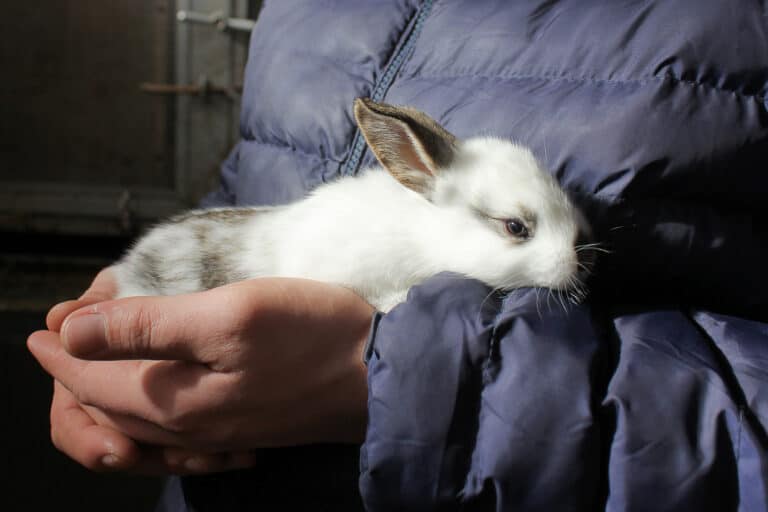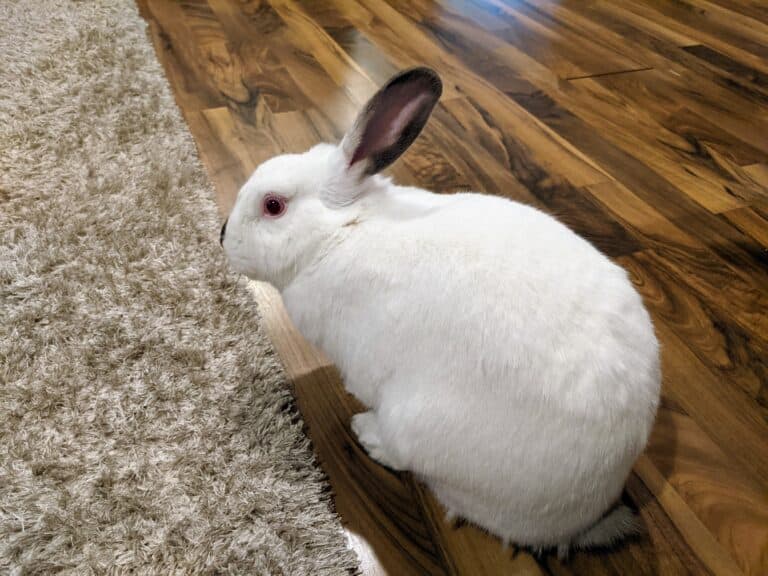Why Is My Rabbit Not Active?

Rabbits are furry bundles of energy. Bun parents are familiar with the zoomies, that frenetic burst of activity rabbits often display. There’s also the binky, which is a sight to behold. Because they’re such energetic pets, a bun who seems lethargic or uninterested in playing worries his humans. No wonder then that the question why is my rabbit not active often comes up in conversations among fur parents.
This post contains affiliate links. Affiliate links support Every Bunny Welcome at no additional cost to you. I receive a commission if you choose to make a purchase through these links.
Common Rabbit Activities
Aside from eating and sleeping, everyday rabbit activities include playing, running, jumping, sometimes over each other, and binkying. If you see your pet indulging in these pursuits, give yourself a pat on the back as they’re signs you have a happy rabbit. Even buns who stay in their cage jump and play. That’s why they need enough space to move around freely.
The zoomies is another common rabbit activity. This is when your little fluff runs through the room like a lunatic, sometimes jumping on and off couches or obstacles. A binky can also be part of the repertoire.

Why Is My Rabbit Not Active?
Because they’re known as fluffy bundles of energy, we understand why seeing your rabbit sitting in one corner and doing nothing can make you worry. Remember, though, that buns get less active as they mature, and senior ones could stop playing altogether. Like humans and other creatures, their energy levels drop through the years, making them uninterested in energetic pursuits.
However, this slowdown comes on gradually. So if your typically adventurous and inquisitive fur baby suddenly stops engaging with you, it could be a sign of illness or other issues and require a trip to the vet.
The problem could be mental or physical. If your little fluff still runs to you and just isn’t as active as before, the problem is likely physical. On the other hand, avoiding all contact could mean your rabbit is experiencing mental turmoil.
Common Reasons Why Your Rabbit Is Not Active
It’s not unusual for rabbits to sit still and do nothing. In the wild, they do so to avoid attracting the attention of predators. With domesticated buns, other reasons for their inactivity include the following.
Boredom
Being intelligent creatures, buns crave mental and physical stimulation. They enjoy learning and playing with new things. So it’s important that they have toys to keep them occupied. The thing is, they get bored easily. Your bun may have gotten tired of the toys in his cage, making him lose interest in playing with them.
Advanced Age
Is your rabbit getting along in years? If that’s the case, you can probably blame his lack of energy on his age. A rabbit’s body experiences the usual wear and tear as years pass. This could lead to problems that restrict movement. Osteoarthritis is a common issue with aging rabbits. As the condition progresses, your pet will move less and might eventually stop engaging in activities that require mobility.
Intimidation
Do you keep two rabbits in one cage? Your inactive bun may have a dominant companion who took possession of all the toys in their hutch. This leaves the subservient one reluctant to play with them, especially if his cage mate shows signs of aggression, such as growling or biting.
Stress or Anxiety
Their sensitive nature makes rabbits prone to stress. Sometimes, ordinary events, such as a barking dog, can cause anxiety in your pet, making him feel uncomfortable in his surroundings. Other signs of anxiety include overgrooming, scratching the floor, and walking in circles.
Heatstroke
Rabbits can’t handle extremes in temperature well. When the ambient temperature goes beyond 32 degrees C (90 degrees F), your pet is vulnerable to heatstroke. In such instances, your fur baby might get lethargic or stop moving altogether. Other signs of heatstroke include panting, drooling, red ears, disorientation, and tremors.
Hypothermia
If your bun becomes sluggish during freezing weather, check if he’s not too cold. Although rabbits can handle low temperatures better than high ones, 20 degrees F can already be dangerous for them. Hypothermia is when your bun’s body temperature drops to low levels after exposure to cold weather.
Consider it an emergency if you see other indications of hypothermia, such as shivering, pale gums and lips, cold ears, and loss of coordination. You could lose your pet in a matter of hours if the situation remains unresolved.
Ailments
Due to their status as prey animals, rabbits often try to hide signs of illness. That makes it tricky to initiate treatment. One of the signs of discomfort rabbits show is lethargy. Buns frequently withdraw from most activities and interactions when they feel out of sorts.

What to Do If Your Rabbit Is Not Active
How you respond to your rabbit’s reluctance to move depends on what’s causing the problem. Here are some techniques you can try.
For Boredom
If you haven’t provided your bun with new toys in a while, try offering new playthings. You don’t have to spend money to motivate your pet to become more active. Simple household stuff like toilet paper tubes, cardboard boxes, and egg crates make good rabbit toys. Also, let your fur baby out of his cage to explore and, more importantly, interact with him to prevent boredom.
For Intimidation
Separate your two buns if they live in one cage. Maybe they haven’t bonded successfully yet, or one may be too timid to claim his share of the resources. The two may get along if they don’t live together under one roof, causing the timid bun to become active again.
For Stress or Anxiety
Stress can impact your pet’s quality of life as well as his lifespan. You can try calming your bun if he looks nervous and see if that will entice him to become as active as before. If he enjoys it, holding your rabbit can help calm him down.
If Heatstroke is the Cause
A short-haired rabbit can handle temperatures of up to 80 degrees F. However, depending on the humidity level, buns can start overheating when the temperature goes up to 85-90 degrees F.
Learn how to distinguish signs of heatstroke and how to quickly cool down your rabbit to prevent serious consequences. Provide plenty of fresh water, leave the AC on if possible, brush your rabbit often, and keep him in the coolest part of the house during hot days.
For Hypothermia
Take your pet’s temperature. If the reading is way below 100 degrees F, warm him up quickly. If your fur baby lives outdoors, consider keeping him inside during freezing weather. You can use a heating pad or wrap your pet in a warm blanket if you suspect that he’s getting too cold.
For Ailments and Reduced Mobility Due to Aging
Taking your pet to a rabbit-savvy vet is the best way to get him the treatment he needs. Your pet’s doctor might also have suggestions on how you can help your senior rabbit regain mobility.
Expect your rabbit to become less active as he ages. However, if he suddenly stops moving or interacting with you, it could be a sign there’s something wrong with him. A quick check-up can rule out any illness, and your vet could help you find solutions to your rabbit’s inactivity.
More on Rabbit Behavior
- Understanding 15 Rabbit Noises and What They Mean
- Why Do Rabbits Lick You? 11 Reasons for This Common Behavior
- Are Rabbits Nocturnal? Tips for Nighttime Activity
- Why Does My Rabbit Nudge Me?
- Can Rabbits See in the Dark?
We hope you enjoyed this post! If you did, will you give it a share or two 🙂 Thank you! ~from Every Bunny Welcome







